9. Online Retailing
Applying Learning and Traditional Tools
In online retailing, shopper behavior follows largely the same patterns as those observed in traditional retail. The lessons from behavioral research remain just as vital, and smart online retailers can equally apply the traditional retailer’s tools and success drivers to improve their site’s performance. However, e-tailing also possesses several unique characteristics that must be recognized and incorporated into planning. The application of the lessons from traditional retail in a framework that take maximum advantage of the unique online opportunities can help retailers optimize their Internet sales results.
Our review of the impact of behavioral research on shoppers in-store tracked relevant studies across the cognitive, logical, social, and biologic underpinnings of behavior. Just as these areas of study explain shoppers actions in-store, they also provide insight into behavior online. For us, e-tailing extends well beyond the acquisition of goods to encompass the entire world of travel and services, so that anyone with an online presence can benefit from the lessons of the research conducted in-store.
Cognitive Research
The virtual world is even more overwhelming than our three-dimensional world. Marketing messages are everywhere, and the shopping options seemingly limitless. We are bombarded with messages at every turn with searches, news reviews, and even email from service providers such as Google. If we did not employ deselection and selective perception to focus on the task at hand, we would never function. However, when we enter a site for shopping, conscious processing assumes a more active role than in-store. Whether we are on Amazon or Craigslist, we have a choice to browse through categories or search for a particular item. Just as we choose our direction in-store, we shape the path we take on our computer screens.
Fatigue remains a critical factor, and the best sites minimize the work that shoppers have to do by structuring their sites using anticipated patterns. In the bricks-and-mortar world, shoppers’ expectations vary by type of outlet, and specialty outlets can create an iconoclastic approach for niche segments.
Outside of niche segments, we would posit that the dominant patterns for shopper expectations have been established by Amazon and Apple. Amazon largely shaped shoppers’ expectation for online retail by being a first mover and focusing on ease of purchase at every step; Apple established themselves as the leader in intuitive interfaces. As they look for ways to minimize shopper fatigue and frustration, e-tailers would be well served to study the shopping logic employed on these sites to establish architecture for their stores (see Figure 9.1).
Figure 9.1 Translating Cognitive Behavior
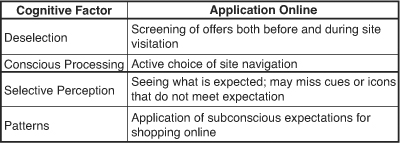
Logical
From a logic viewpoint, the shopping process online is similar to that followed in-store. The difference is that the process is more formal, including a direct opportunity to offer additional items for addition to the shopping basket (see Figure 9.2). As with all retailing, we need to balance the offering of additional items for sale with a risk of exhausting shoppers’ patience with the process. Suggestions that have meaning to the shopper will be rewarded; those that are seen as an intrusion will not only result in a lack of response to the offer, but they also may lead to abandonment of the site for other options.
Figure 9.2 Store/Online Parallels

Social
Purchasing online is less of a group activity than shopping in a physical store. Social influencers are important in the shopper’s choice of a site to visit, but less so when it comes to navigating the site. The shopping dynamic is an amalgam of conscious and unconscious processes. However, the social forces that shape shopping behavior, as shown as Figure 9.3, affect the choice made prior to the visit much more than those during the visit.
Figure 9.3 Social Forces and Shopping Behavior
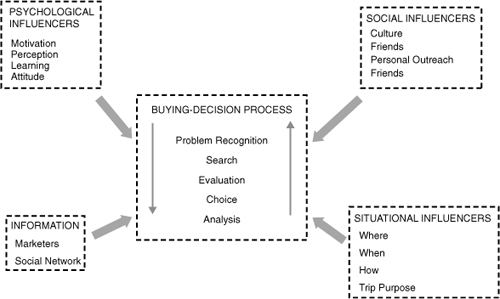
However, online shopping affords the opportunity for building powerful virtual communities. These play a vital role in reaffirming your choice of an online retailer and, when used properly, can also drive incremental sales today and tomorrow. These can range from eBay’s seller ratings and online communities, to Walmart’s offers to connect customers through reviews and online discussion groups, to Amazon’s reviews and recommendations from other readers. In each case, the community deepens the involvement of the shopper with the site so that they feel a sense of ownership and belonging.
Biologic
Our response to visual stimulation remains the same in both worlds: Images trigger activity in different parts of our brains, and we can thereby use imagery to promote the desired result. Too often we see e-tailers miss the opportunities afforded by vibrant imagery. At one extreme, we have sites such as Craigslist that are a series of typewritten categories on a white screen. At the other end, we see lifestyle brands such as American Apparel highlighting its products as they are used every day and tapping into aspirational imagery with interactive contests, such as its search for the “best bottom in the world.”
Decision Drivers
The decision drivers that lead to e-tail success mirror those within bricks-and-mortar stores, and are detailed in Figure 9.4. The shopper must choose the site, find the category, and then select an item. She must then interact with the item and place it in the shopping basket. With skillful planning and execution, the e-tailer convinces her to add an additional item to the cart and check out. To help the shopper along the way, the online retailer optimizes search results so that the largest number of potential shoppers visit its site. It uses site design and page presentation to trigger the necessary item interaction and position layers of information and interactive elements so that the shopper can chose his own level of immersion in the item experience. The e-tailer presents thoughtful complementary items that the shopper might be open to. These can be a combination of items related by use or interest, or items recommended by like members of the online community that shops this site. Finally, the e-tailer makes the checkout process as quick and painless possible.
Figure 9.4 Decision Steps and Success Drivers

Home Page
Much like the store exterior, the home page works as the shopper’s entry point into the online store. It should be clean and inviting and support the brand image. It is critical that you offer opportunities to buy at every turn. Highlight key items, promote bargains, and, most important, if people return for a visit, suggest items that should have interest to them based on their history with you.
The best sites keep track of your history and make suggestions on the item you failed to purchase the last time you visited and related items. These take the form of Amazon’s “you viewed this; others who viewed this item also viewed this,” eBay’s tracking of items you viewed, and Apple’s recommendations on potential new purchases based on your most recent purchases. This personalization extends beyond retailing of goods to services, so that the best travel sites remember where you stayed and your previous itineraries so that you can efficiently rebook.
The key for online stores is that the layout fit with expected patterns and that the offerings have meaning to the shopper. Online retailers have a dominant paradigm they can reference in leading sites that have clearly established the expected shopping template. They also have a tremendous edge over bricks-and-mortar stores in that they can personalize their site to specific return shoppers.
Site Navigation
Site navigation is the corollary to store layout. We have seen that the best retailers configure their stores so that they can efficiently serve their shoppers’ varying needs, so savvy grocers create layouts allowing shoppers to move through the entire store on their main shopping trip and also efficiently visit the front of the store for a midweek complete meal solution. Likewise, effective e-tailers give shoppers options when they visit their sites so that they can peruse the site in a variety of ways or efficiently search for a single item. If you are a repeat visitor, they give you a shortcut to consummating the purchase you abandoned on the last visit, perhaps reminding you of an intended purchase that was set aside. If the site offers consumable products such as groceries, it keeps track of previous orders or offers the ability to build shopping lists so purchasing entire orders becomes simplified. With proper design, the shopper is empowered, and all the necessary information is at hand so that you can easily finalize a purchase at any point on your visit to the retail site.
Page Design
When the shopper has moved past the home page, the page design is critical. Key elements of the best pages’ designs include
• Browsing activity
• Items with meaning to the shopper
• Efficient communication of essential information such as price, size, and so on
• Opportunities to self-select more information to support purchase decision
• Ability to consummate a purchase at any point in the process
• Related items offered for purchase
Let us briefly walk through a typical shopping visit. The shopper visits the site and decides to browse an aisle (for traditional retailers) or a category (for e-tailers). The best sites offer a choice for deeper penetration of the category but also immediately suggest items that might spur immediate purchase activity based either on previous history, timeliness, or special promotion. Once the shopper selects an item, all the necessary information is presented on the page so that the shopper can efficiently compare alternatives in one place. If more information is needed, the shopper can delve deeper into the details. Importantly, at every step, related items are offered for purchase so that the value of the transaction is maximized.
Although these may seem obvious, many e-tailers who get other parts of the equation right miss significant opportunities to optimize purchases as shoppers move through their site. Thus, Safeway presents only a listing of options with no suggested or promoted items offered when you enter an aisle. E-tailers such as Lisa Frank get almost everything wrong by not even including pricing on its page views. This makes it impossible to compare items in the category. The shopper must click on each item to view the price and repeat the process for every offering. The inefficiency is maddening as compared with most sites, and results in tremendous lost opportunities for shoppers who are highly interested in purchasing.
Page Organization
Research firms specializing in eye-tracking studies have established that we view screens in much the same way we view our three-dimensional world.1 Whether we are watching a television screen or a computer monitor, our eyes find the object of interest and then move around that item to take in other items in the area. Our behavior on the screen is similar to that measured by Dr. Hugh Phillips in-store.2 Design is the key to focusing attention so that the page view results in a sale. Much as retailers use clean lines and bookending to focus attention, strong e-tailers design their pages so the attention is focused, and shoppers do not wander down a series of options that overload the senses and lead to an abandonment of the site without making a purchase. At the same time, pages should not be too pristine, or you will miss the opportunity to create a related sale.
Purchase Drivers
The essential elements involved in deciding to purchase are the same whether the sale is consummated online or in a three-dimensional retail environment. Consequently, the purchase drivers (visibility, access, ease of purchase, communication/education, and involvement) are vitally important to optimizing results. The application of these drivers requires adjustments in strategy and takes a slightly different expression to increasing sales.
Visibility
Online visibility relates to our ability to see items and their marketing message onscreen. As shoppers orient themselves upon entering a store, they also orient themselves on an e-tailer’s home page. What they see is directly related to the relevance the offerings have to them on this visit. Contrasting the online store with traditional retail, retailers can better influence the path of shopper traffic in-store but must generally position items that will pass within view against identified shopper segments; e-tailers can more precisely target the items shown to the shopper based on previous visits and the shopper’s activity on this visit. As e-tailers increase their knowledge of what is driving the shopper’s visit, they have the opportunity to increase the relevance of the items presented so that visibility can be greatly enhanced (see Figure 9.5).
Figure 9.5 Product Exposure Comparison
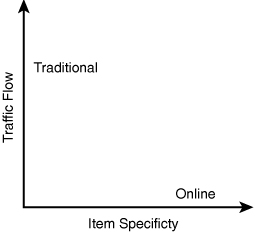
Access
Access online is driven by the relative exposure of the product to shoppers. Obviously an item such as the Kindle, which is the dominant feature on Amazon’s home page, has a much greater product access than a branded electronic item found only through a shopper-directed search. Likewise, a new release from a best-selling author bannered on all book searches will have much greater product access than individual book titles from the catalog that appear only when requested. The greater the exposure or access to the product, the higher the sales will be, as a portion of the shoppers to whom the item is presented will find relevance in the offering and make a purchase. For e-tailers, sales are maximized when product access closely correlates to relevance to the shopper (see Figure 9.6).
Figure 9.6 Access and Relevance Impact
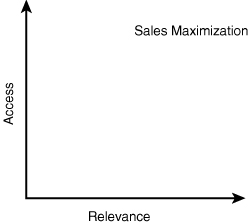
Ease of Purchase
As we saw in-store, the easier it is to make a purchase, the more shoppers will buy. Online ease of purchase takes various forms:
• Reminding shoppers of the items they viewed on their last visit
• Suggesting items of similar interest to the previous items purchased
• Intuitively recommending items based on current searches
• Suggesting intelligent add-on items
• Making it easy to repeat consumable purchases (stored lists, preferences, or itineraries)
• Relevant responses to searches
• A quick path to purchase finalization after a choice is made
Incomplete information, a tedious order consummation process, and irrelevant search results lead to frustration. The bar for intuitive responses and ease of use at every step of the process creates a high level of expectation for all e-tailers.
Communication/Education
The research in-store shows us that education is a tool that must be applied with great precision. Complex categories respond positively to a depth of information, but sales can decrease as the amount of information grows and shoppers become overwhelmed. In retail stores, the marketer must make an educated choice about the amount of data to be presented and carefully gauge shopper responses to find a general sweet spot.
The online world offers a relatively simple path to optimizing communication. Savvy online merchants present the product simply so that those who know what they want or do not want to be confused with too much information have a clear path to purchase. At the same time, they offer a “more info” option so that those who are unsure can gather additional details. The best merchants extend the discussion to their online communities so that group feedback can provide a third-party validation and added assurance to those contemplating a purchase. The technique works for books and technical purchases, and the capability to layer information gives online retailers the opportunity to have shoppers customize the amount of information they need.
Involvement
Although online stores cannot replicate the experience of a tactile interaction with the product offered for sale, they have multiple opportunities for shoppers to get involved with offerings. Involvement techniques include samples of books or music, videos of products in use, and introductions to online communities of users and reviewers. For nonmerchandise offerings such as travel, sites can offer the opportunity to view the property, virtually tour the room, or get excited about sights in the area. The key for involvement is that it has meaning for the shopper, and the multiple pathways offered through intelligent web design provide the shopper with a choice of the level and type of involvement that will have meaning.
Managing Online Dynamics
The principles of good retailing and tools for optimizing the shopping experience apply in three-dimensional and online stores. Each environment has unique opportunities and limitations, and the best practitioners find ways to maximize their opportunities. Online retailers cede control of the navigation after their home page to shoppers. They can influence navigation in their careful introduction to the shopping experience. They have tremendous opportunity to make the items they present relevant by reacting to previous searches and the shoppers’ activity during their visit.
Site volume is a function of the total transactions that result in a sale and the size of the shopping basket. These are influenced by the ease of purchase and the relevance of the items presented to shoppers during their visit. Online winners make their transaction easy to complete on each visit and leverage the information provided by the shopper to increase the number of items selected for purchase (see Figure 9.7).
Figure 9.7 Online Volume Dynamic

Online Tools
Applying the lessons from the research in retail stores online leads us to ten tools for increasing online success.
Tool #1—Optimize Search and Existing Points of Contact
Before shoppers can buy from your site, they need to find it. If you are a giant of online retailing, shoppers are aware of your offering and will find you. Online merchants with a presence in the traditional retail world need to have a clear strategy for what they want to accomplish online and then maximize every contact point to drive shoppers onto their online sites. Online retailing will never replace brick-and-mortar. However, online sales are an important part of total sales activity, and their share of sales will continue to grow. Using existing interactions with consumers to drive visits online builds brand preference and can ensure that you retain customers and grow your share of their total spending.
For all merchants selling online, it is important that you optimize search. Consumers who use a search engine are qualified customers. You need to work to make sure that your store appears in the search so that you get consideration and visits. In the traditional retail world, new shoppers find your store by walking through a mall or a shopping district and noticing your exterior. In the online world, search is the counterpart to the stroll through the mall, and you need to make sure that you are presented where shoppers are looking.
Tool #2—Operate Within Dominant Shopper Patterns
Shoppers use shortcuts and unconsciously reference patterns when shopping online just as they do in traditional stores. By incorporating the patterns associated with the dominant online retailers, you support the unconscious expectation of shoppers and make your site seem easier to use and more intuitive to navigate. This comfort with the shopping environment promotes greater relaxation that encourages the shopper to linger and increases the number of items that are considered for inclusion in the shopping basket. By contrast, introducing a new navigation pattern causes shoppers to think about what they are doing at each step and can lead to fatigue and a potential abandonment of the first purchase without even considering secondary items.
Tool #3—Make the Site Meaningful to Shoppers
If your site is a means of purchasing a desired product, shoppers will visit, buy the single item, and leave. This scenario delivers a measure of volume but does not optimize the opportunity the medium offers.
Shoppers are considering a purchase because it relates to something of interest and meaning to them. As food relates to cooking, song downloads to music, and hotel rooms to travel, shoppers online are fulfilling a need that is part of a larger interest. The more you can make your site meaningful to that larger interest, the more of their purchases you will earn, so that you become the preferred site for that area of interest.
Tool #4—Implement a Multiplatform Strategy
When you have presence in the traditional and online worlds, look for ways to make each presence reinforce the other. Executed properly, the online experience makes the store visit easier and more rewarding, whereas the store visit drives shoppers online as a way to extend the store and increase the role the website plays within that area of interest for shoppers.
Apple executes this strategy well as it encourages shoppers to register certain store activities online and even have them work on a computer in-store if they failed to preregister. Thus appointments at the Genius Bar are scheduled online. If you want to buy an iPhone, you enter the necessary information online. If you do this from home, the process is fast; if you do not, an associate helps you complete the process on a computer. The result is that the physical store and the online presence are linked, visitation to the site is encouraged, and you quickly learn that the online presence is an extension of the store to be visited before a planned trip.
Tool #5—Personalize Your Offerings
Relevancy drives response. Traditional retailers need to focus their offerings on an identified group of shoppers to maximize relevancy. Online merchants can focus the offering on a unique individual. Smart e-tailers incorporate past visits and purchases into their recommendation. The best refine their recommendations based on current site visits.
Tool #6—Motivate Desired Behavior
All retailers make more money with a larger shopping basket. But most online merchants face an additional hurdle associated with the direct marketing model. Direct marketers have a relatively fixed cost to pack, process, and ship an order, so that an order for a single $10 item is most likely unprofitable, whereas an order for ten of the same item totaling $100 will be highly profitable. Shoppers need to factor the delivery charge into their acquisition cost. As handling and shipping costs are spread over multiple items, their impact diminishes, and the order becomes more profitable for the merchant with a lower per-item delivery cost for the shoppers.
Although the break-even point varies dramatically across different merchants, the best merchants understand the profit dynamics associated with building an order and incorporate incentives into their offerings so that shoppers become willing partners in building the merchant’s profitability.
Poor operators, such as Lisa Frank, remain mute on order size and leave shoppers to find their own way through their online stores. With a low average ticket per item, shoppers are surprised by the weight of the delivery charges and will abandon their shopping basket or be frustrated with the experience and less likely to return.
By contrast, smart operators, such as the Oriental Trading Company, sell merchandise with roughly the same average price but offer incentives to their shoppers to earn free shipping by building their order to defined dollar levels. Shoppers know what the shipping charge is likely to be up front and factor that into their shopping behavior as they browse the site. The result is an average order size above the industry average that fulfills the merchant’s goals and satisfies the shoppers in achieving a total order target size they set.
Tool #7—Analyze Data
Merchants online possess unprecedented levels of data on shoppers’ behavior when they visit their sites. They can leverage that data to understand where shoppers abandon their purchases and when shoppers respond to offers. They can test alternative scenarios in real time and measure responses. By leveraging the malleability of the medium and the granular data available, they can gain greater understanding of their shoppers’ behavior online so that they can identify offers and techniques that optimize close rates and the frequency with which secondary items are added to the order.
Tool #8—Layer Your Information and Immersion
Traditional retailers have to navigate a treacherous strait in determining the amount of information to be offered on shelf. Take advantage of the flexibility the Internet offers by keeping the information simple on the initial page and then positioning layers of involvement and immersion behind this offering. If shoppers just want to verify that the book is the one they are seeking by looking at the cover, let them simply make their purchase at this point. If the shopper wants to consider the book by looking through the chapters and seeing what other people said about the book, give them that opportunity as an option. If the shopper is interested in the topic and not sure of which book to purchase, support her search by suggesting related titles. This approach, favored by Amazon, lets shoppers choose their level of involvement and supports the predominant shopping patterns for books.
A contrasting approach would be to list all the technical information associated with a computer on the initial page offering. This technique unnecessarily reflects a traditional retail decision in which your choice on information is static. This approach can overwhelm the casual shopper and lead to indecision that causes her to abandon your site. A better approach is to replicate the Amazon book offering with a simple benefits presentation that is fast with sharp pictures, and so on. For shoppers who want more information, you can offer opportunities to view technical data, reviews, evaluate alternatives, and so on.
The online store is a flexible medium. The best online merchants use that flexibility so that shoppers easily get the experience that is most relevant to them.
Tool #9—Connect and Involve
After you connect with your shoppers, connect them with each other to deepen the relationship with your site. Look for opportunities to create communities of shoppers so that you create a connection that extends beyond the goods and services offered. Examples range from eBay, which was an early mover in creating communities, to Walmart, which hosts discussion groups around broad topics for young families and posts a series of blogs. Understand the areas of interest to your shoppers and create reasons for them to use your site as a portal to their interests so that you have additional contact points.
Tool #10—Leverage the Path to Purchase
With greater precision than traditional retail, online shoppers follow a defined path to purchase. Look for opportunities to recommend a relevant additional item at each step along that journey. The worst practitioners approach the shopping process clinically. When you enter a category, they will list an option in script to one side with no visuals, or provide only the information that is necessary to assist with your navigation to the next page. Mid-level performers offer purchase selections in addition to the navigation tools, but do not take advantage of the entire page. The best sites combine navigation tools with personalized suggestions, timely suggestions, and top sellers. To avoid overload, they clearly define the sections and keep them consistent throughout all the categories offered.
The optimal page design, as shown in Figure 9.8, approaches the page in quadrants, with navigation tools on the left, timely offerings in the upper middle, personalized selections in the bottom middle, and bestsellers on the right. Too often retailers miss the opportunity to suggest additional items by not leveraging one of these quadrants.
After the decision to purchase has been made, suggest related items before taking the shopper to the checkout page. While at the checkout page, offer one more opportunity to build the order.
Figure 9.8 Recommended Page Design
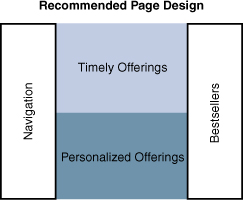
Endnotes
1. Hugh Phillips, “The Power of Marketing at Retail,” Alexandria, VA, POPAI (2008), pages 41-43.
2. Ibid., 37-39.
